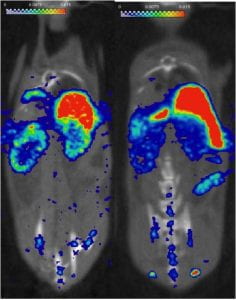Northwestern Professor Daniel Batlle, Earle, del Greco, Levin Professor of Nephrology/Hypertension in the Feinberg School of Medicine, is working on using shorter forms of Angiotensin-converting enzyme (ACE2) as a therapy for kidney diseases. The devastation of COVID-19 has pushed many researchers to think of ways to treat patients by borrowing therapies and ideas from similar viruses like SARS-CoV (2002-2004) and Ebola. ACE2 has been demonstrated to be the main receptor for the spike protein in SARS-CoV and recently SARS-CoV-2. The soluble, i.e. shorter, ACE2 molecule developed by Batlle and Wysocki could be used as a competitive interceptor of SARS-CoV-2, thereby preventing infection (Main Image).
 In Figure 2, radiolabeled ACE2 is used to compare distribution of a soluble short ACE2 (left) and full size soluble native ACE 2 (right). Chemistry of Life Processes Institute’s Center for Advance Molecular Imaging provides state-of-the-art Single Photon Emission Computed Tomography (SPECT) imaging to visualize differences in the two ACE2 molecules. Although Figure 2 is a 2D presentation of the data, SPECT provides quantitative, in vivo, noninvasive, 3D data.
In Figure 2, radiolabeled ACE2 is used to compare distribution of a soluble short ACE2 (left) and full size soluble native ACE 2 (right). Chemistry of Life Processes Institute’s Center for Advance Molecular Imaging provides state-of-the-art Single Photon Emission Computed Tomography (SPECT) imaging to visualize differences in the two ACE2 molecules. Although Figure 2 is a 2D presentation of the data, SPECT provides quantitative, in vivo, noninvasive, 3D data.
References:
Soluble Angiotensin-Converting Enzyme 2: A Potential Approach for Coronavirus Infection Therapy? Daniel Batlle, Jan Wysocki, Karla Satchell Clin Sci (Lond) 2020 Mar 13;134(5):543-545. doi: 10.1042/CS20200163. PMID: 32167153 DOI: 10.1042/CS20200163
